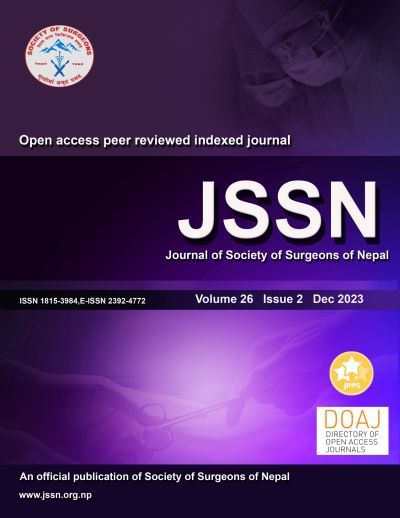Comparison of stone clearance rate based on upper, middle, or lower calyx puncture in Mini Percutaneous Nephrolithotomy (mPCNL)
DOI:
https://doi.org/10.3126/jssn.v26i2.63623Keywords:
PCNL, Puncture, Renal accessAbstract
Introduction: PCNL is the most common surgical technique used for the management of renal stones, particularly for those with more than 2 cm stones. The aim of this study is to identify which kidney calyx—upper, middle, or lower—when punctured achieves the highest stone clearance rate.
Methods: This was a prospective non-randomised study performed in department of urology, KIST medical college from September 1, 2021 to November 16, 2022. Patients who underwent PCNL were evaluated with detailed history, examination, and investigation. All the patients who fulfill the inclusion criteria during study period were included in the study. After preoperative investigation PCNL was done according to standard protocol. Perioperative complication recorded in Performa. Stone-free status was checked after 2 months of surgery with ultrasonography.
Results: 100 patients were included in this study among which 59 were male. The mean age of patients was 33.35 years [range 18-65 years]. Upper, middle and lower pole puncture was done in 23%, 33% and 44% patients respectively. The mean stone burden of the patient was 380.680 mm2. The average time for surgery according to access was 67.34 mins, 63.12mins, and 64.07 mins for the upper calyx, mid-calyx and for the lower calyx respectively. 84.33% of patients had complete stone clearance after 2 months in the USG examination. 91.3% [21] had stone clearance when approached through the upper calyx. It was 87.8%[29] by mid calyx and 75%[33] by lower calyx. Upper calyx puncture had statistical significance in stone clearance rate [P=0.43, P=0.021, P=0.002]. 11 had CRIF ≤4mm stone in PCS, and the remaining 6 had residual stone >4mm. In our study, thoracic complications were significantly higher in upper calyx puncture 8[30.4%, 8[24.24% in the middle calyx, and 3[6.8%] in lower calyx [P=0.02, P=0.98, P=0.03] respectively.
Conclusion: Upper calyceal puncture can produce the highest stone clearance rate, but it has been associated with significant postoperative morbidity, particularly in the chest. Lower calyx punctures have less intraoperative and postoperative morbidity, but their stone removal rates are lower than those of other procedures. Therefore, the balance between stone clearance rate and morbidity has been achieved using middle calyx puncture.
Downloads
Downloads
Published
How to Cite
Issue
Section
License
Copyright (c) 2023 The Author(s)

This work is licensed under a Creative Commons Attribution 4.0 International License.




